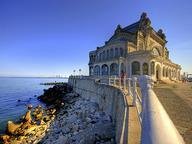Quiz Answer Key and Fun Facts
1. In the 2nd century A.D., the Roman Empire reached its greatest extent under the Emperor Trajan. His army conquered a kingdom that had its capital at Sarmizegetusa, and many Romanians claim that their identity as a separate culture began when the Romans left and Daco-Roman peasants and shepherds remained. What was this kingdom called?
2. One of the iconic scenes in Transylvania is the image of a cobbled street lined by pastel coloured houses with steeply sloping tiled roofs. This is part of the style to be found in the fortified towns of Saxon heritage that provide focal points for the Transylvanian region. Seven of these towns in particular give rise to the German name for Transylvania. What is this?
3. Transylvania is a region consisting of wonderfully scenic settings from deep valleys to snow-covered mountain peaks. It is an area surrounded by many mountains, which act as a natural barrier that separates it from the surrounding regions. Which large mountain range are its boundaries part of?
4. Although Transylvania is now part of Romania, it has a very strong connection to the Hungarians. One of the major ethnic groups in the region has significant Hungarian elements to it, with enough unique traits to be classed on their own. Which ethnic group does local legend claim to be directly descended from the Huns?
5. Thanks to the work of Bram Stoker, Count Dracula will forever be associated with Transylvania. The furore surrounding this fantastic character has led people to connect him to the 15th century historical figure that is popularly known as Vlad the Impaler. Vlad was born in which of the Saxon fortified towns that is also recognised by UNESCO as a World Heritage Site?
6. The region of Transylvania contains hundreds of Saxon fortified churches. Some of the finest examples have even been added to UNESCO's List of World Heritage Sites. Of these, one particularly fine example lies not far from Brasov and despite being under siege on numerous occasions in its history, it only actually fell once when it was taken by the Translyvanian Prince Gabriel Báthory. Where is this fortified church?
7. One of the most popular tourist destinations in Romania is Bran Castle. It is set on a forested hill in a beautiful mountainous setting, and is a fine example of the many castles in the region. What name is it popularly known as?
8. To get a feel for the rural, isolated life that exists in Transylvania, you could do worse than take a car off the main road down a rough dirt track for around 7km to the village of Viscri. Here you will find another of UNESCO's wonderful fortified Saxon churches, but which personality was so enchanted by the area that they actually purchased a property here?
9. In 2007, one of Transylvania's cities was rewarded with the title of European Capital of Culture. It hosts an international film festival, is home to the Brukenthal Museum and is thought to be the place where Samuel Hahnemann invented homeopathy. Is also claims one of the largest open-air museums in the world, where many buildings from all over Romania have been collected in one beautiful forested setting. Which city?
10. In 2007 Romania entered the European Union. In order to bring the country in line with other members of the economic block they passed a new law later that year. What type of transport was banned from Romania's roads that would have been a regular sight when travelling across Transylvania?
Source: Author
ajwtimperley
This quiz was reviewed by FunTrivia editor
Exit10 before going online.
Any errors found in FunTrivia content are routinely corrected through our feedback system.

